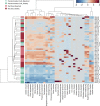Stable mucus-associated bacterial communities in bleached and healthy corals of Porites lobata from the Arabian Seas
- PMID: 28361923
- PMCID: PMC5374439
- DOI: 10.1038/srep45362
Stable mucus-associated bacterial communities in bleached and healthy corals of Porites lobata from the Arabian Seas
Abstract
Coral reefs are subject to coral bleaching manifested by the loss of endosymbiotic algae from coral host tissue. Besides algae, corals associate with bacteria. In particular, bacteria residing in the surface mucus layer are thought to mediate coral health, but their role in coral bleaching is unknown. We collected mucus from bleached and healthy Porites lobata colonies in the Persian/Arabian Gulf (PAG) and the Red Sea (RS) to investigate bacterial microbiome composition using 16S rRNA gene amplicon sequencing. We found that bacterial community structure was notably similar in bleached and healthy corals, and the most abundant bacterial taxa were identical. However, fine-scale differences in bacterial community composition between the PAG and RS were present and aligned with predicted differences in sulfur- and nitrogen-cycling processes. Based on our data, we argue that bleached corals benefit from the stable composition of mucus bacteria that resemble their healthy coral counterparts and presumably provide a conserved suite of protective functions, but monitoring of post-bleaching survival is needed to further confirm this assumption. Conversely, fine-scale site-specific differences highlight flexibility of the bacterial microbiome that may underlie adjustment to local environmental conditions and contribute to the widespread success of Porites lobata.
Conflict of interest statement
The authors declare no competing financial interests.
Figures



References
-
- Knowlton N. & Rohwer F. Multispecies Microbial Mutualisms on Coral Reefs: The Host as a Habitat. Am Nat 162, S51–S62 (2003). - PubMed
-
- Rosenberg E., Koren O., Reshef L., Efrony R. & Zilber-Rosenberg I. The role of microorganisms in coral health, disease and evolution. Nat Rev Micro 5, 355–362 (2007). - PubMed
-
- Rohwer F., Seguritan V., Azam F. & Knowlton N. Diversity and distribution of coral-associated bacteria. Marine Ecology Progress Series 243 (2002).
-
- Muscatine L., Falkowski P. G., Porter J. W. & Dubinsky Z. Fate of photosynthetic fixed carbon in light-adapted and shade-adapted colonies of the symbiotic coral Stylophora pistillata. Proc Roy Soc Ser B Biol Sci 222, 181–202 (1984).
-
- Mouchka M. E., Hewson I. & Harvell C. D. Coral-Associated Bacterial Assemblages: Current Knowledge and the Potential for Climate-Driven Impacts. Integr Comp Biol 50, 662–674 (2010). - PubMed
Publication types
MeSH terms
Substances
LinkOut - more resources
Full Text Sources
Other Literature Sources

